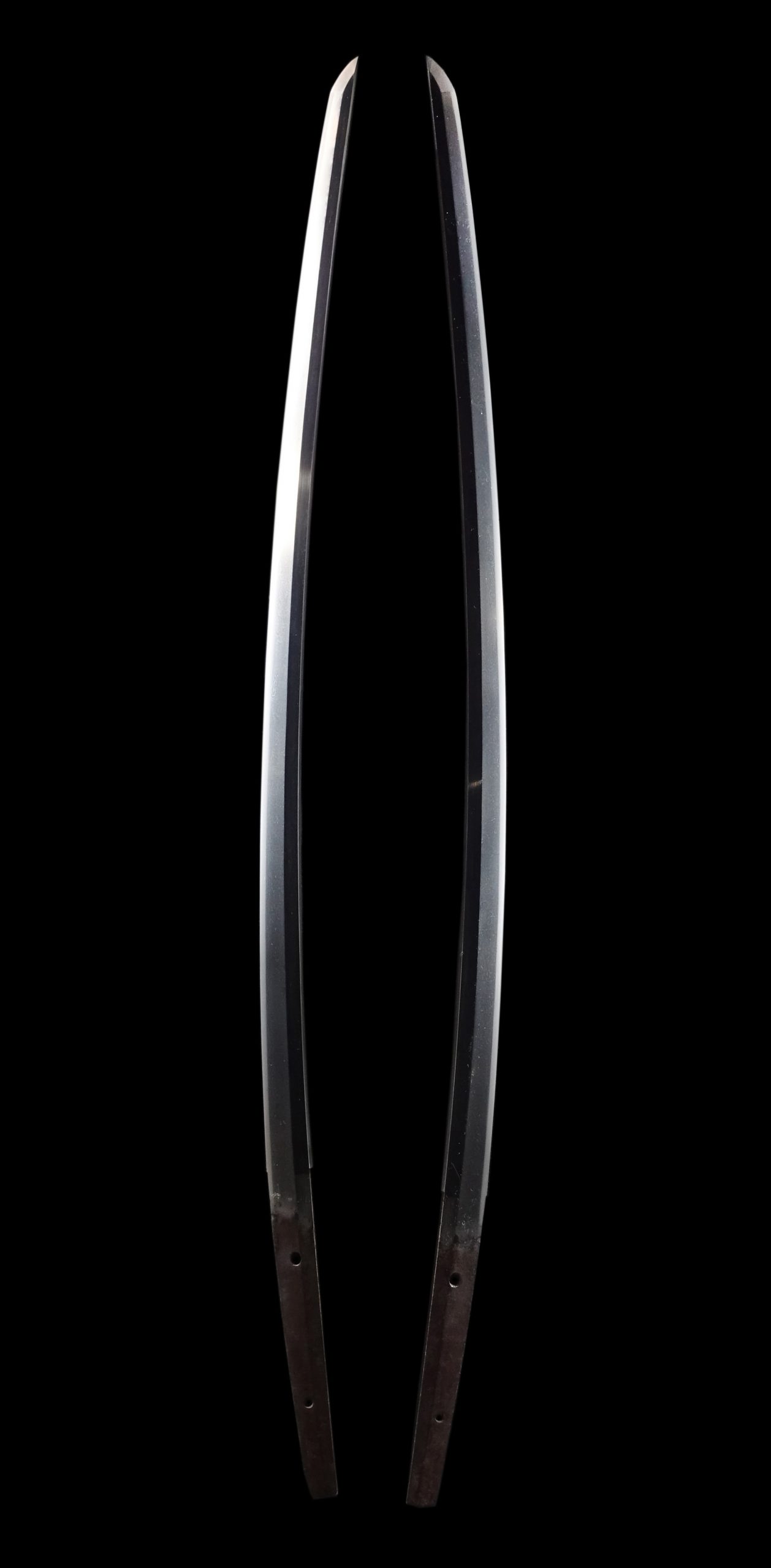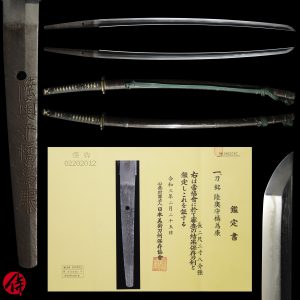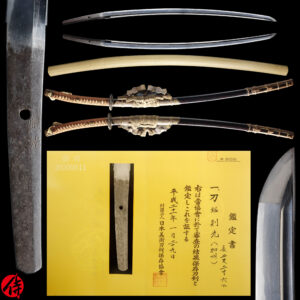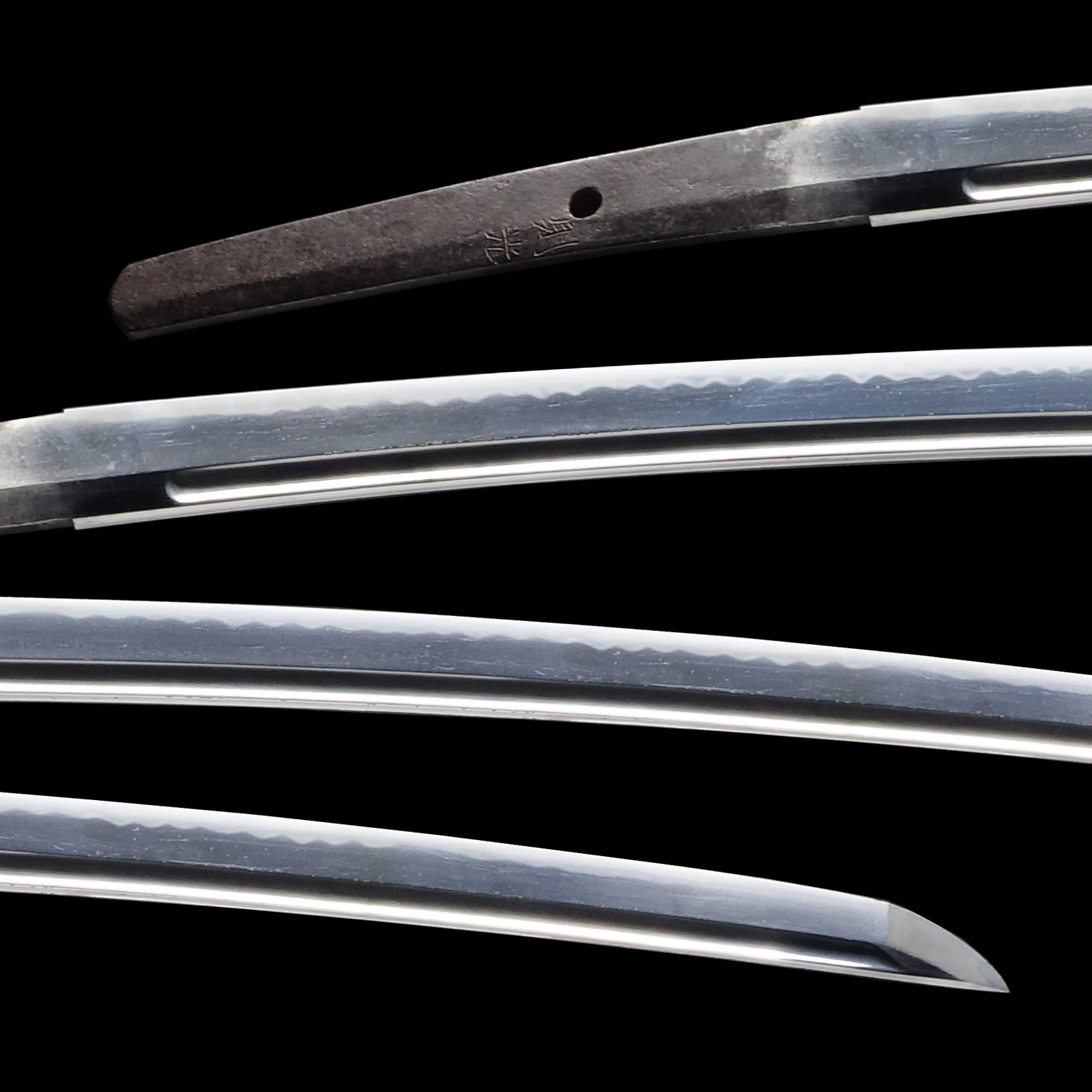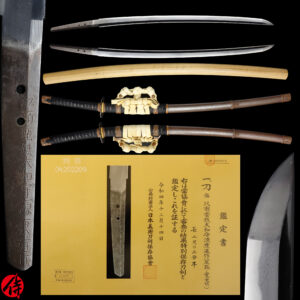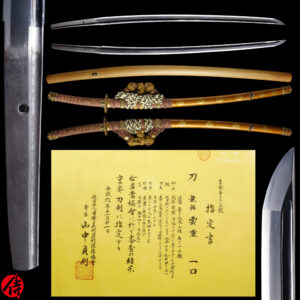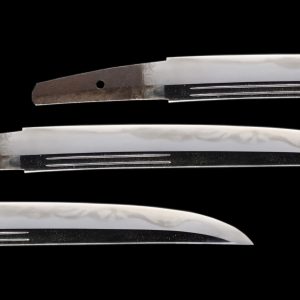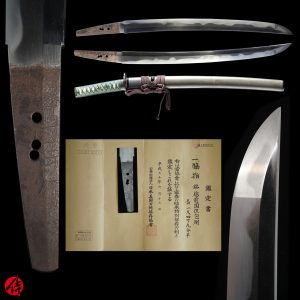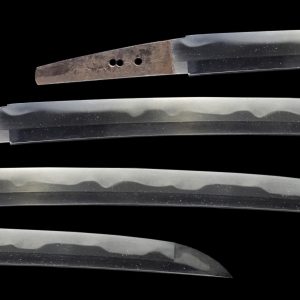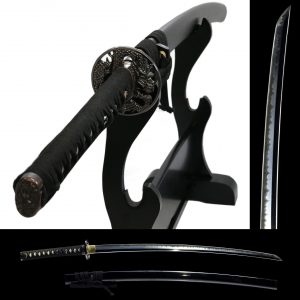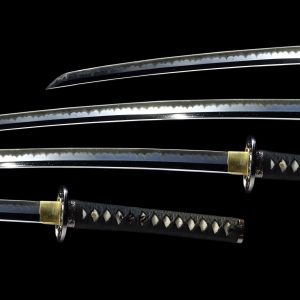Antique Japanese Sword Tachi Unsigned Nioh with NBTHK Tokubetsu Hozon Certificate
【Description】
According to NBTHK that authenticated the blade, it was forged by one of Nioh’s swordsmiths. Although the authentication paper doesn’t say when it was made, we contacted NBTHK to confirm its age. They believe it was created during the late Kamakura period(about 700 years old) based on the blade’s characteristics. This school mastered superb craftsmanship, and it is known as one of the most famous schools in this region.
Nioh is the group of swordsmiths(school) that flourished from the mid-Kamakura period to the late Muromachi period(500-750 years ago) and lasted until the Edo period(150—400 years ago).
The school was founded by Nioh Taro Kiyotsuna(二王太郎清綱) in Suo Province(today’s Yamaguchi prefecture). According to his remaining work, the oldest blade was forged in 1265. It is currently enshrined in Itsukushima Shrine in Hiroshima. It is said that he started to forge swords in around 1205(early Kamakura period). The Nioh swordsmiths inherited the part of its founder’s name 清(Kiyo) such as 清房(Kiyofusa), 清長(Kiyonaga).
There were a lot of lands in Suo Province controlled by the Todaiji temple in the Kamakura-Muromachi period. It is said that Nioh school and Yamato swordsmiths from Nara prefecture had a strong relationship and technological exchange.
That is why the blades forged by Nioh swordsmiths had a strong influence from YAMATO-DEN.
*Todaiji temple is located in Nara prefecture. Before the Edo period, temples and shrines gained strong political influence.
The name Nioh came from the legend that the Tachi blade forged by Kiyotsuna(the founder of Nioh school) was able to save the Nioh statue by cutting the chain connected to it when Nioh temple was on fire.
Another theory was that Nioh swordsmiths lived in a village called Nioh no Sho(二保庄) and started to call themselves Nioh swordsmiths.
Considering how old it is, this blade is remarkably well preserved, and its appearance is elegant. We assume this blade might have been initially owned by the imperial lineage or one of higher authorities back then.
An incredibly beautiful Koshirae(sword mounting) is also worth mentioning. It is categorized as Tachi koshirae(Horseback style). This Koshirae was also authenticated as Tokubetsu Kicho Item(Rare Special Item) by NBTHK. The Koshirae is newer than the blade, but this mounting’s delicacy is aesthetically pleasing to look at.
This blade is appraised as Tokubetsu Hozon certificate issued by NBTHK. This authentication paper was only given to Japanese swords, especially worth preserving by Nihon Bijutsu Touken Hozon Kyokai(the Society for the Preservation of the Japan Art Sword).
【 Blade】
Cutting Edge Length(Nagasa): 63.3 cm( 24.9 inches)
Curvature(Sori):1.8 cm( 0.7 inches)

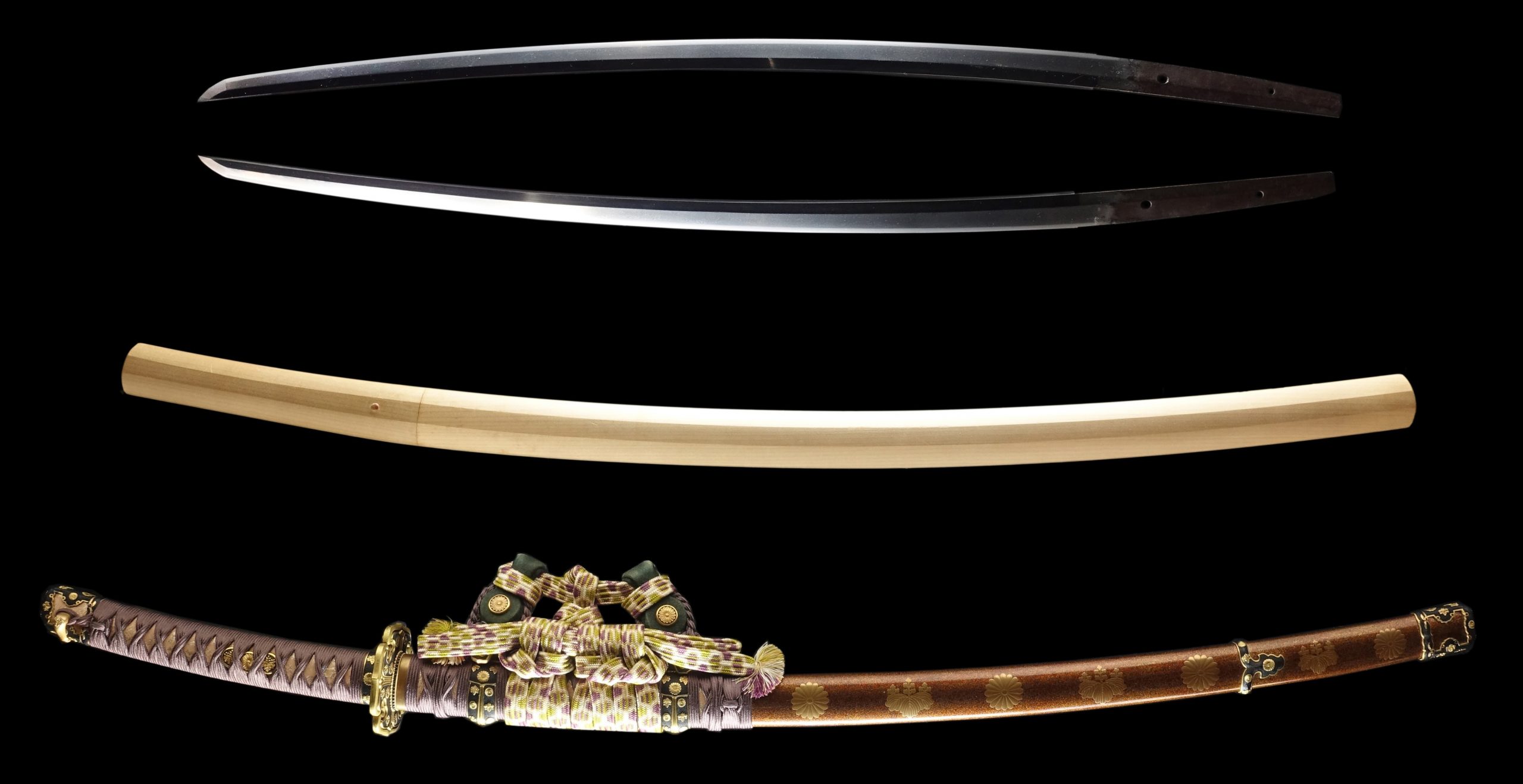
Hamon:
The crystalline structure which forms along the cutting edge of a blade as a result of the hardening process
Jimon(Jihada):
visible steel surface pattern created by folding and hammering during forging process
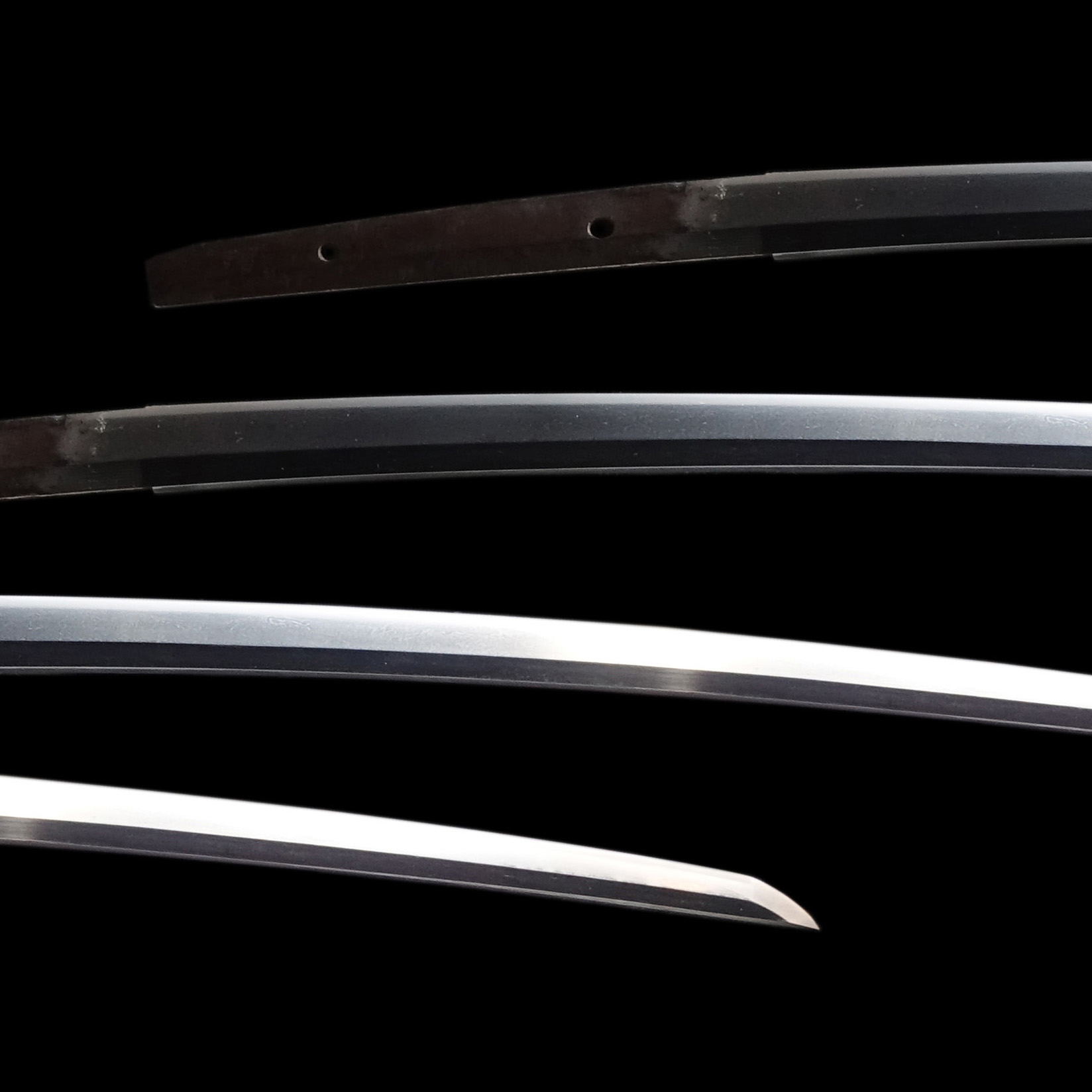

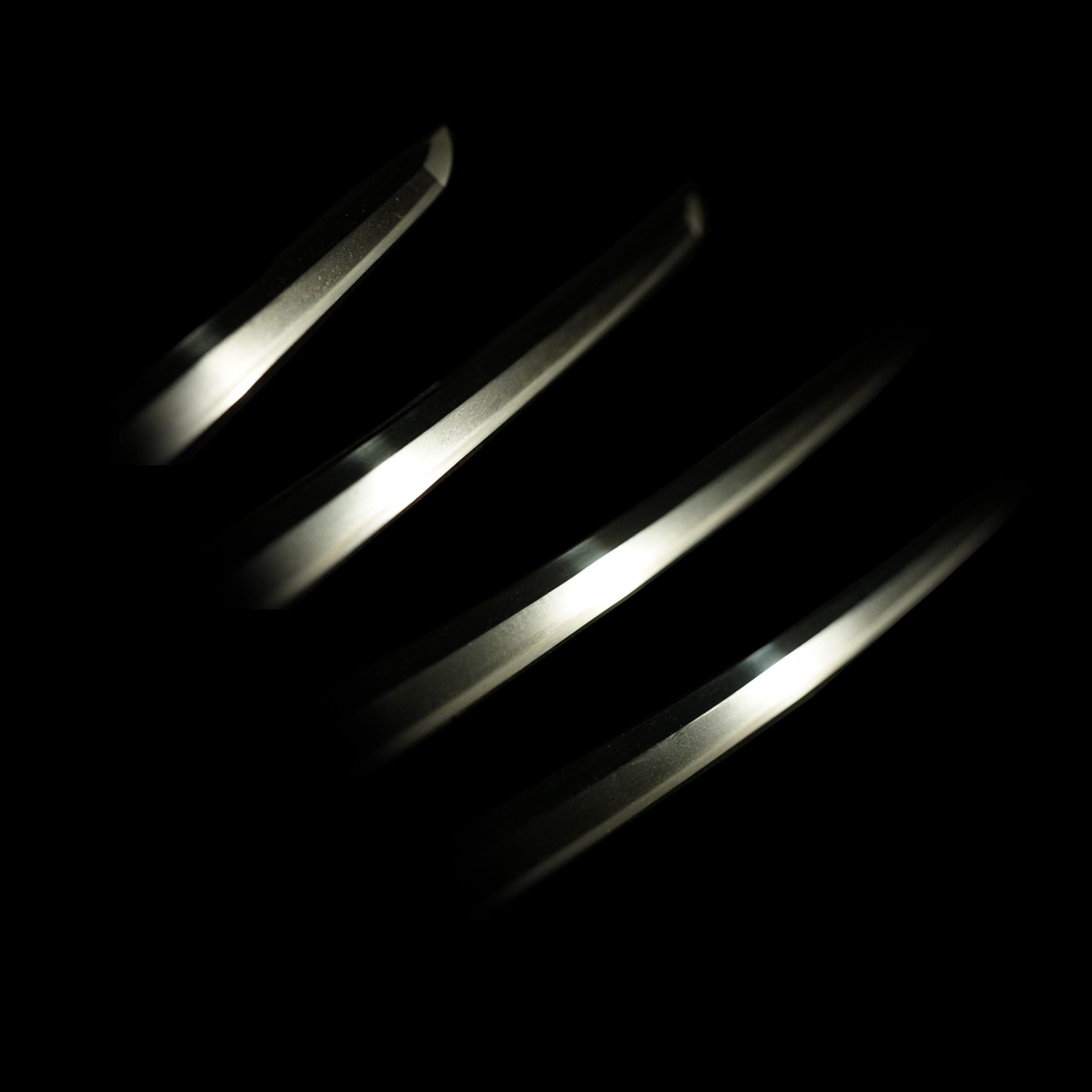
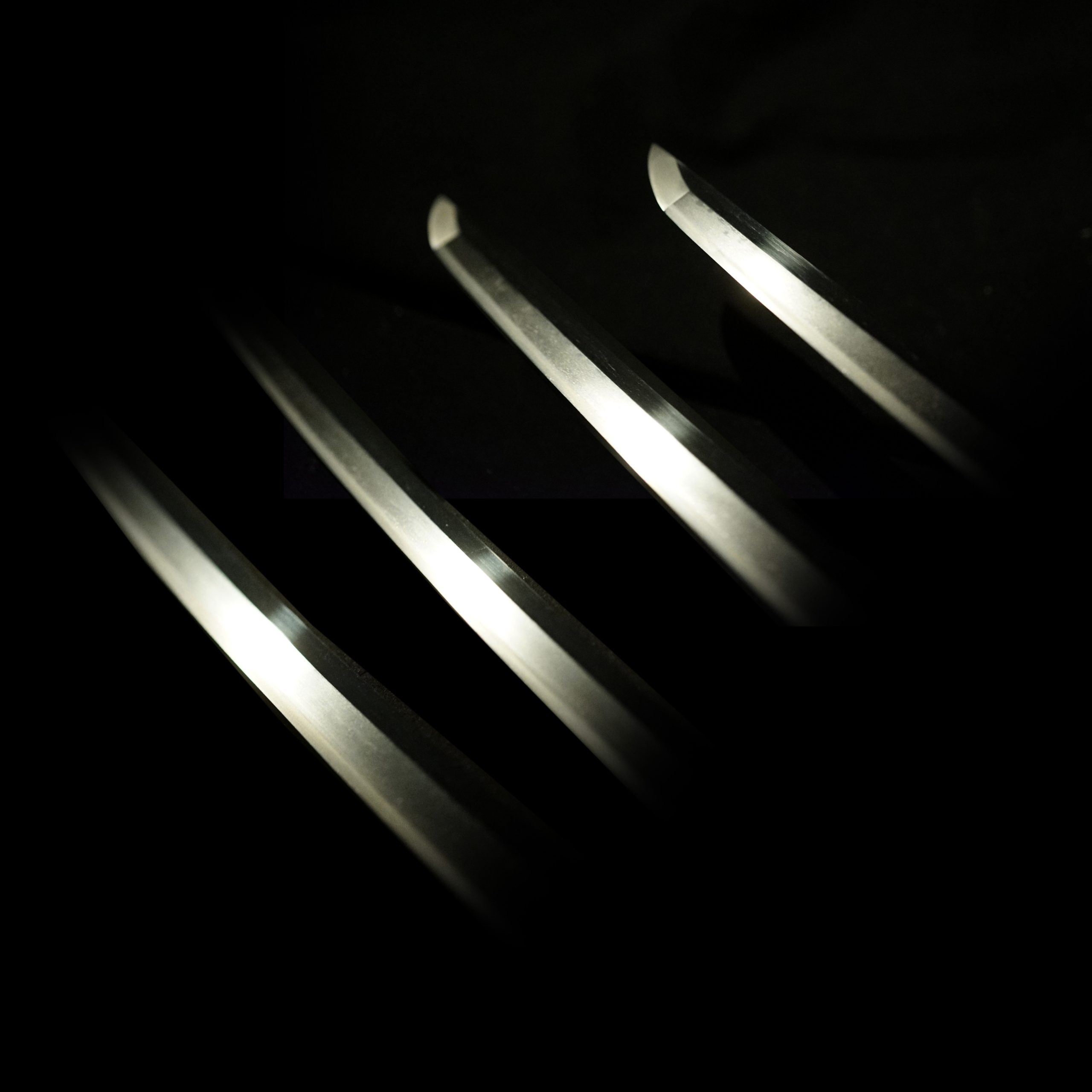
Nakago:Nakago is the tang of the Japanese sword.
We believe this blade was shortened at least once based on the two Nakago holes. Japanese swordsmiths left the black rust on the tang because it prevents red rust while the tang is in its handle. And the discoloration of the tang was created over time, and it is a great indicator for a Japanese sword specialist to estimate when the sword was forged.

Koshirae: Koshirae is the mounting of the Japanese sword. There are several parts that consist of Koshirae such as Saya(Scabbard), Tsuka( Handle), Tsuba(Handguard).

Fuchi-Kashira:A pair of matching sword fittings that cover the upper and bottom parts of its sword hilt.
The Gosan-no Kiri (五三の桐) and chrysanthemum patterns are arranged alternately. The Kiri (桐, paulownia) pattern is composed of three standing straight inflorescences and three leaves. The number of flowers that are blooming at each inflorescence means the ranks of this design. For example, the Goshichi-no Kiri (五七の桐) pattern has five-seven-five flowers for inflorescences. So that this is a more high-ranked design than Gosan-no Kiri (three-five-three flowers) pattern, this motif is known as the symbolic design of the Japanese government. It is also famous that one of the most popular Samurais in Japan: Toyotomi Hideyoshi used the Kiri pattern for his family crest. This plant pattern was once used by the imperial family and national leaders of the time. However, today, it is often used by ordinary people.
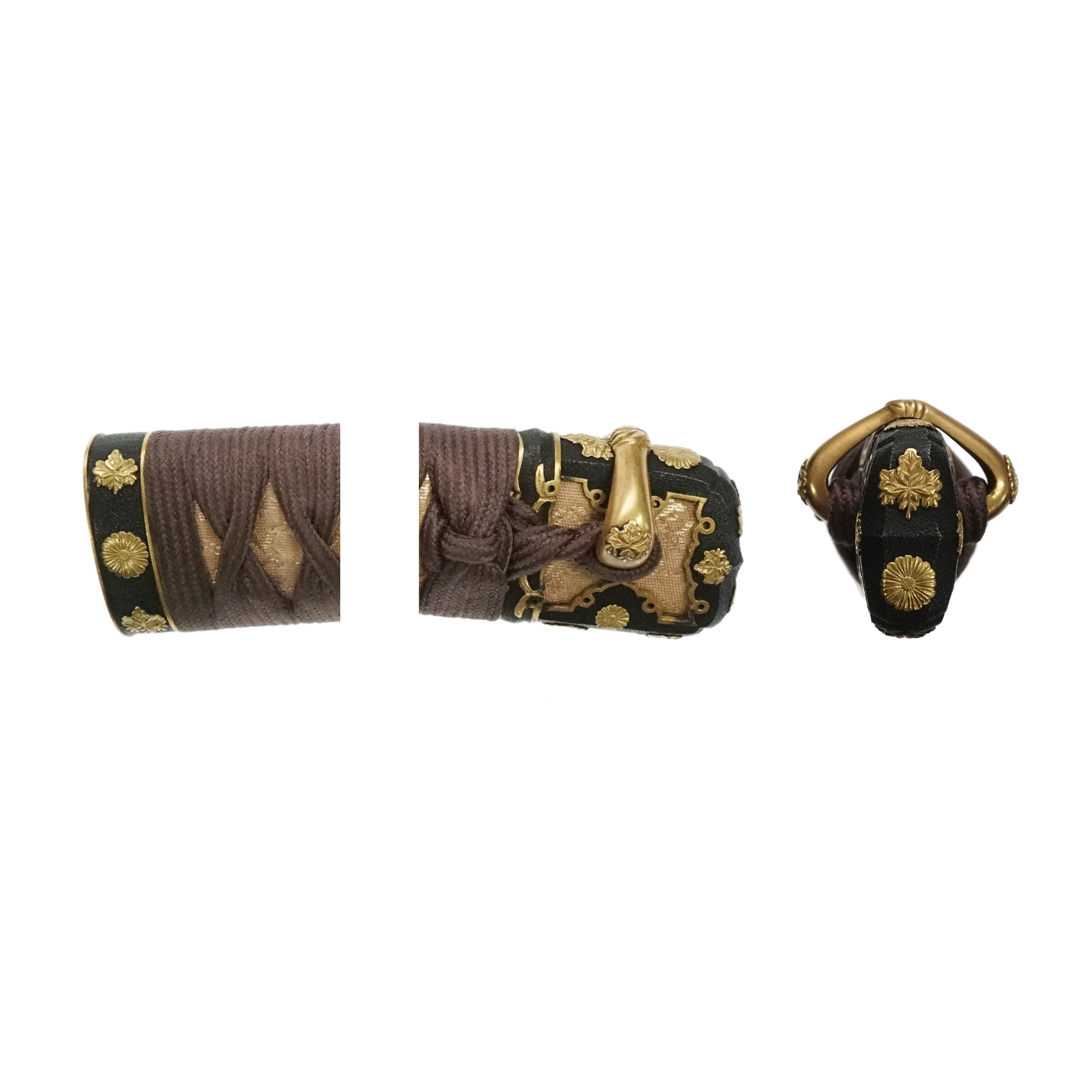
Tsuka and Menuki:Tsuka is the handle of the Japanese sword and Menuki is its decoration.
A chrysanthemum is sandwiched between two paulownias. The same motifs unify this sword’s mountings.
A long time ago, the chrysanthemum was used as a medicine for obtaining a long life in China, and it was brought to Japan with this thought in the Nara period (648-781). Chrysanthemum is one of the flowers which symbolizes fall, and people appreciate it very much since ancient times. As its petals form radially, the chrysanthemum has been likened to the sun. That is why this flower pattern is treated as the symbol of perpetual youth and longevity or good health.
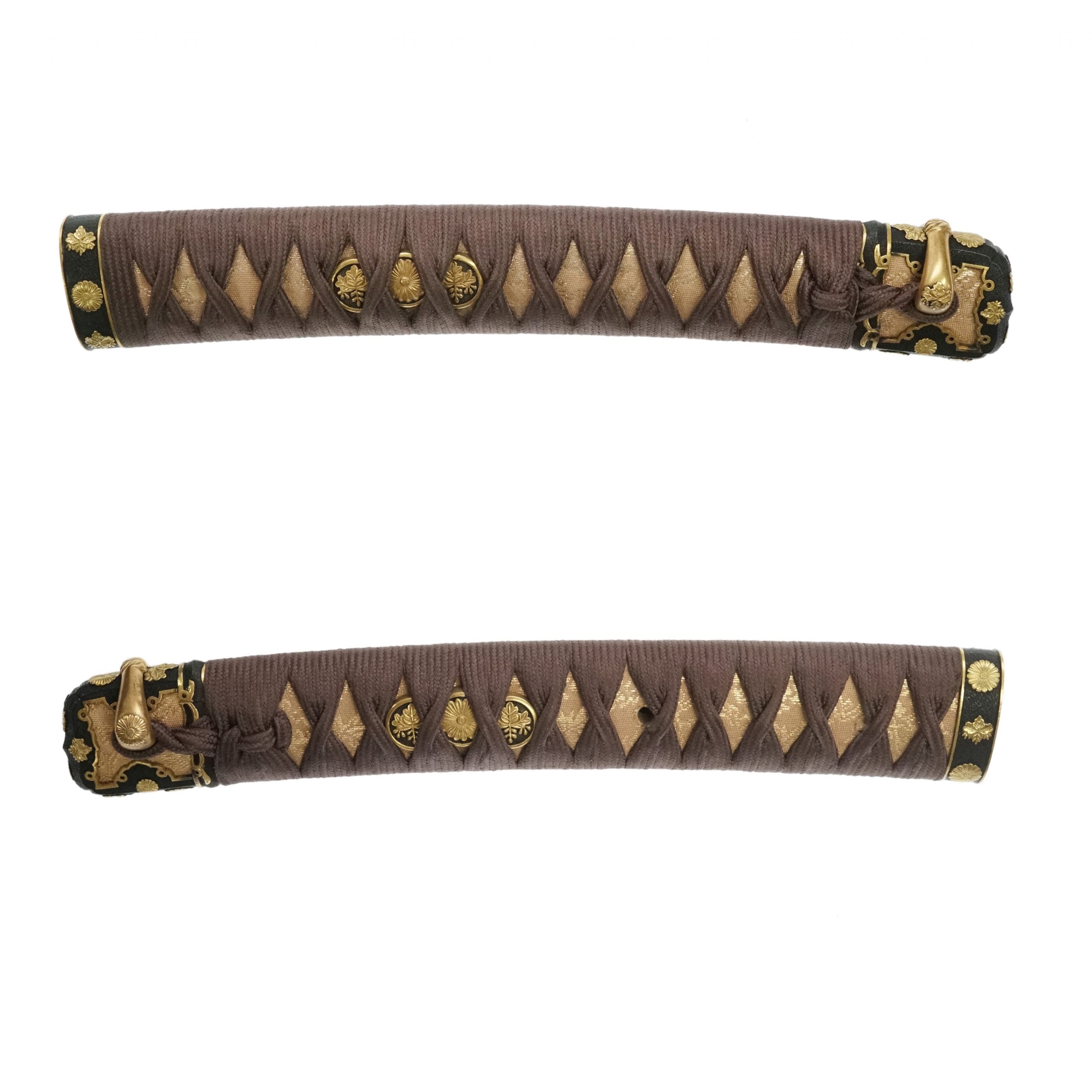
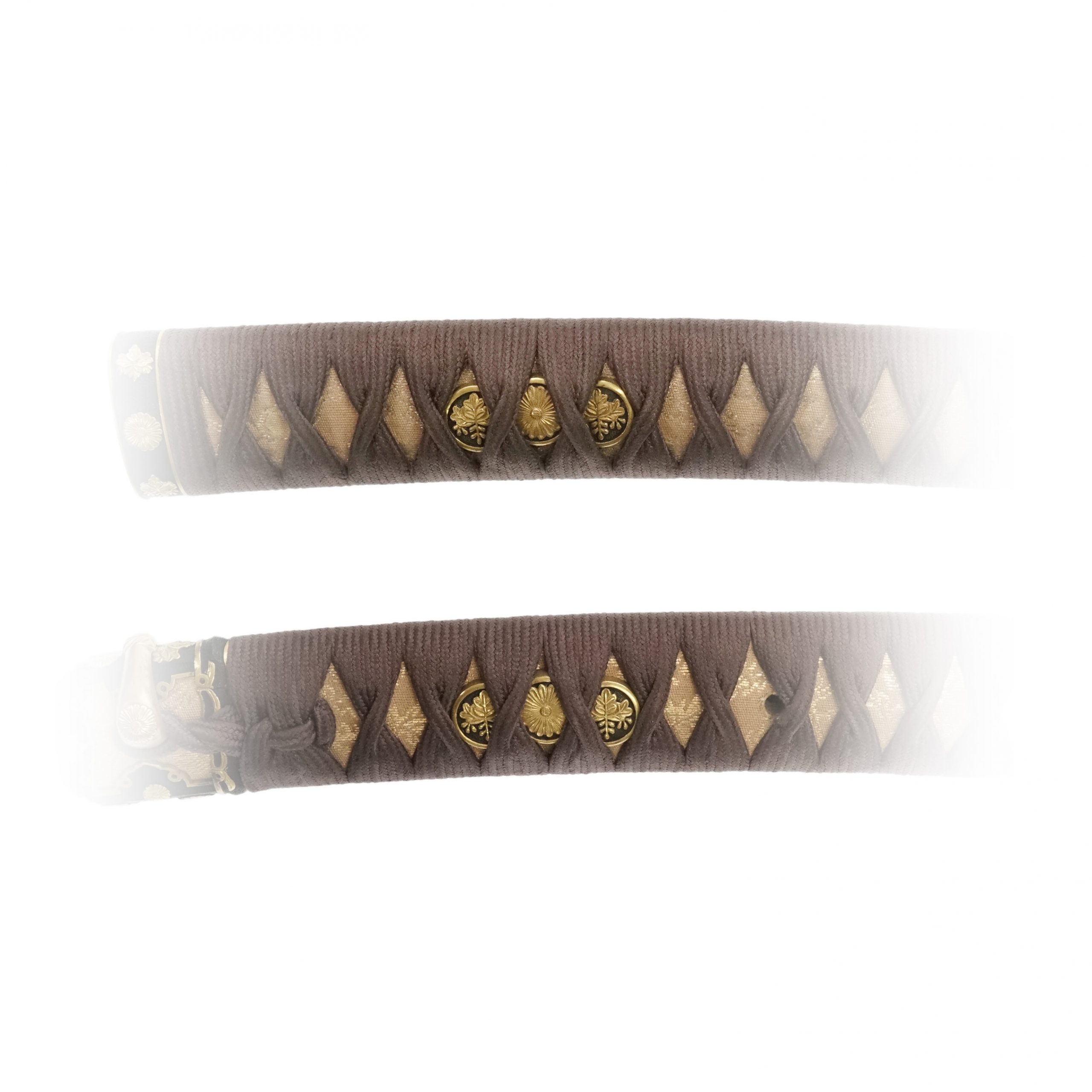
Tsuba and Habaki:Tsuba is the handguard for the Japanese Sword and Habaki is the equipment to make the blade not touch its scabbard inside. It prevents the blade from getting rusty and chipped.
This Tsuba is decorated with common plant motifs as well as Fuchi Kashira and Menuki. The decoration remains in good condition, and the contrast of black and gold colors gives us a noble impression. You would find heart marks at four corners and top, bottom, right and left. This design is called Inome (猪の目) patten in Japanese and is often seen in architecture in shrines or temples. This pattern is used for a long time. Its name comes from the eyes of boar. Some people believed that the Inome would work as an amulet to protect them from evil spirits or fire. Also, it is said it would bring good luck.

Saya: Saya is the scabbard for the Japanese sword.
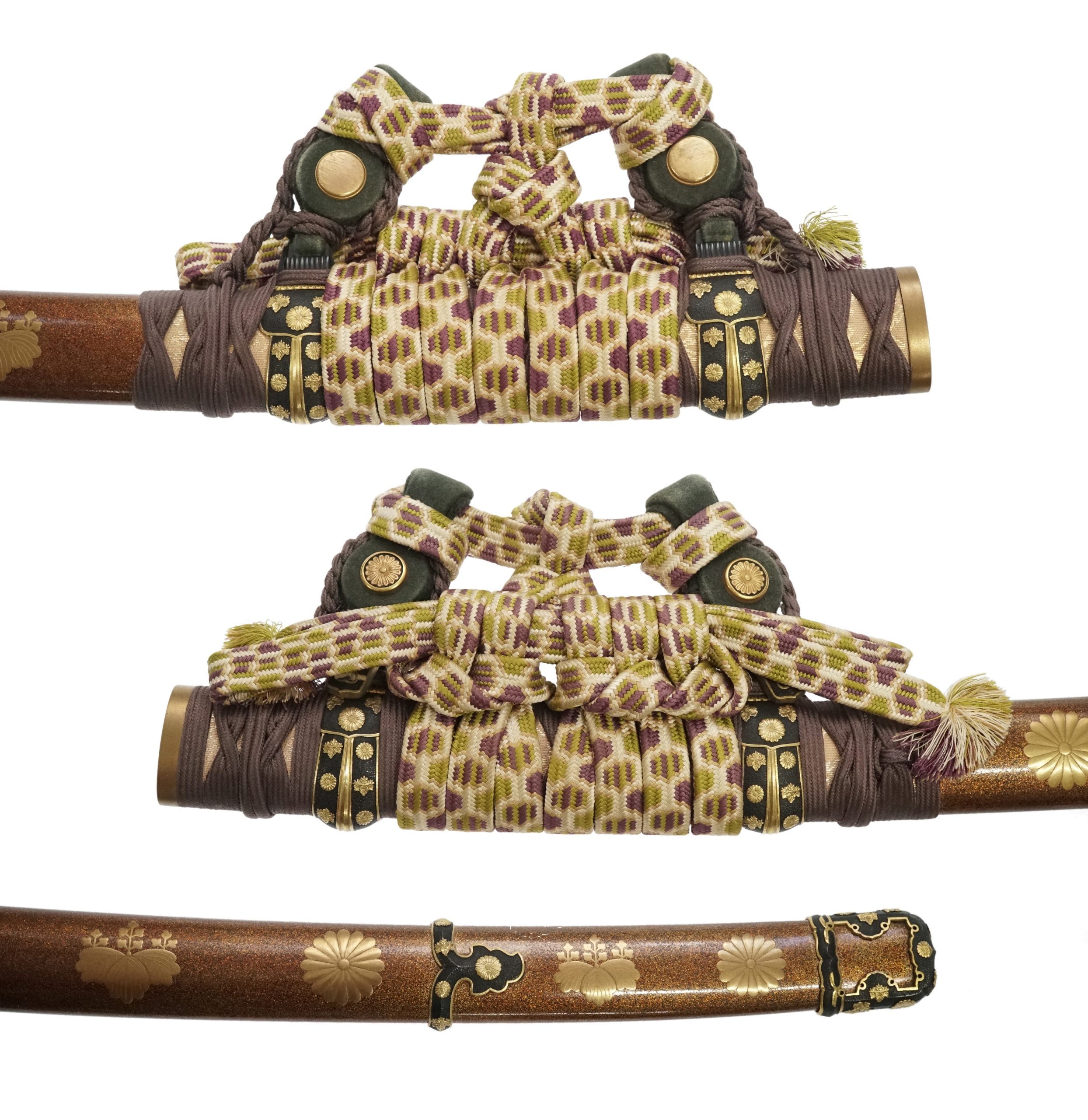
Authentication Paper:NBTHK TOKUBETSU Hozon Certificate for the blade, Tokubetsu Kicho Certificate for the Koshirae
NBTHK, also known as Nihon Bijutsu Touken Hozon Kyokai (the Society for the Preservation of the Japan Art Sword), is one of the oldest Japanese sword appraising organizations in modern-day Japan. They authenticated the blade on Aug 6th in the 10th year of Heisei (1998). They appraised it as Tokubetsu Hozon Touken, the blade especially worth preserving for Japanese society.
Its Koshirae(Sword mounitng) was appraised as Tokubetsu Kicho by NBTHK on Sep 20th in the 45th year of Showa (1970). The last part is blurred out because its owner’s name back then is written.
The purchaser will receive this original certificate as well. We can also translate what is written into English and make a PDF file for your record if you request.
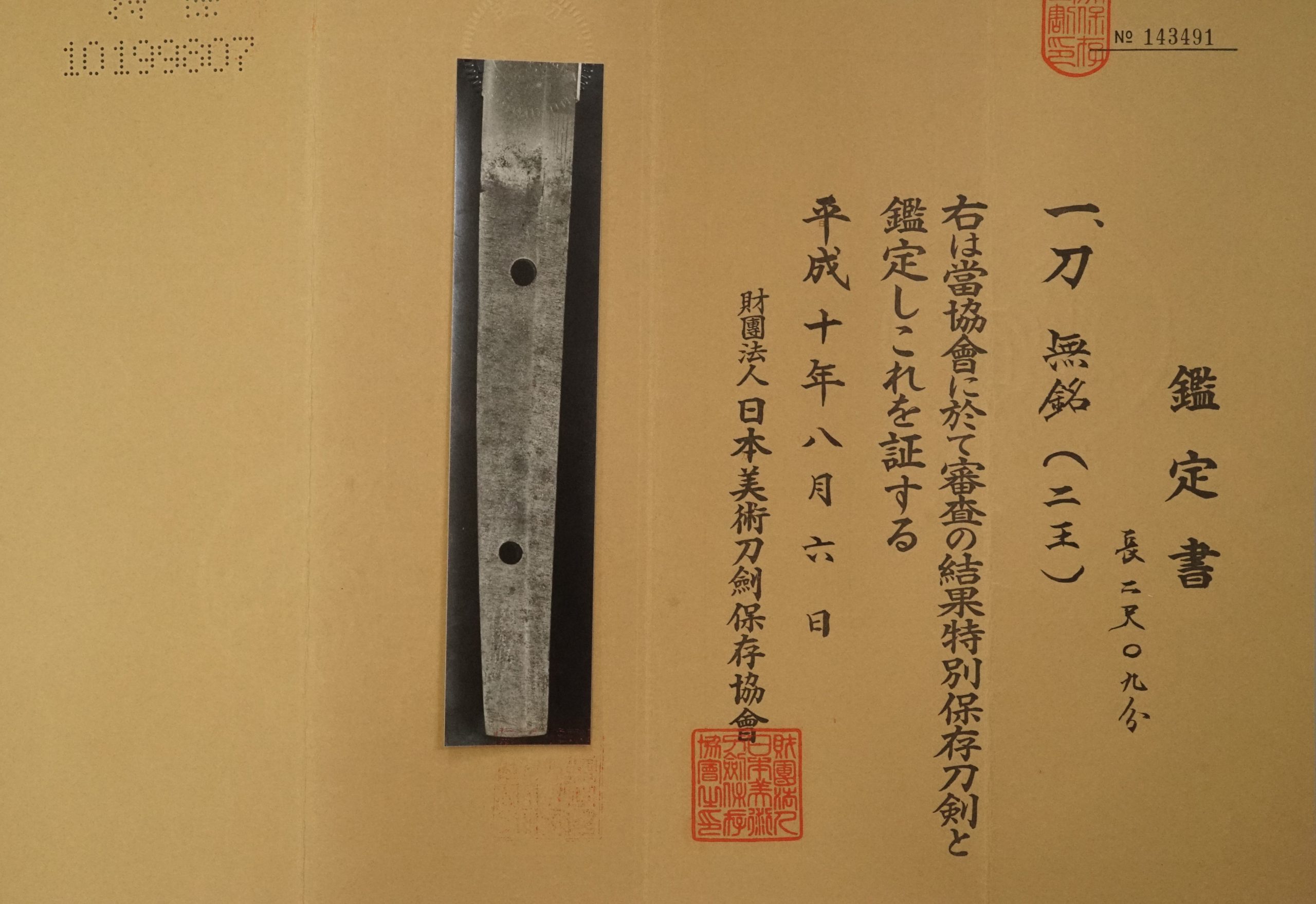
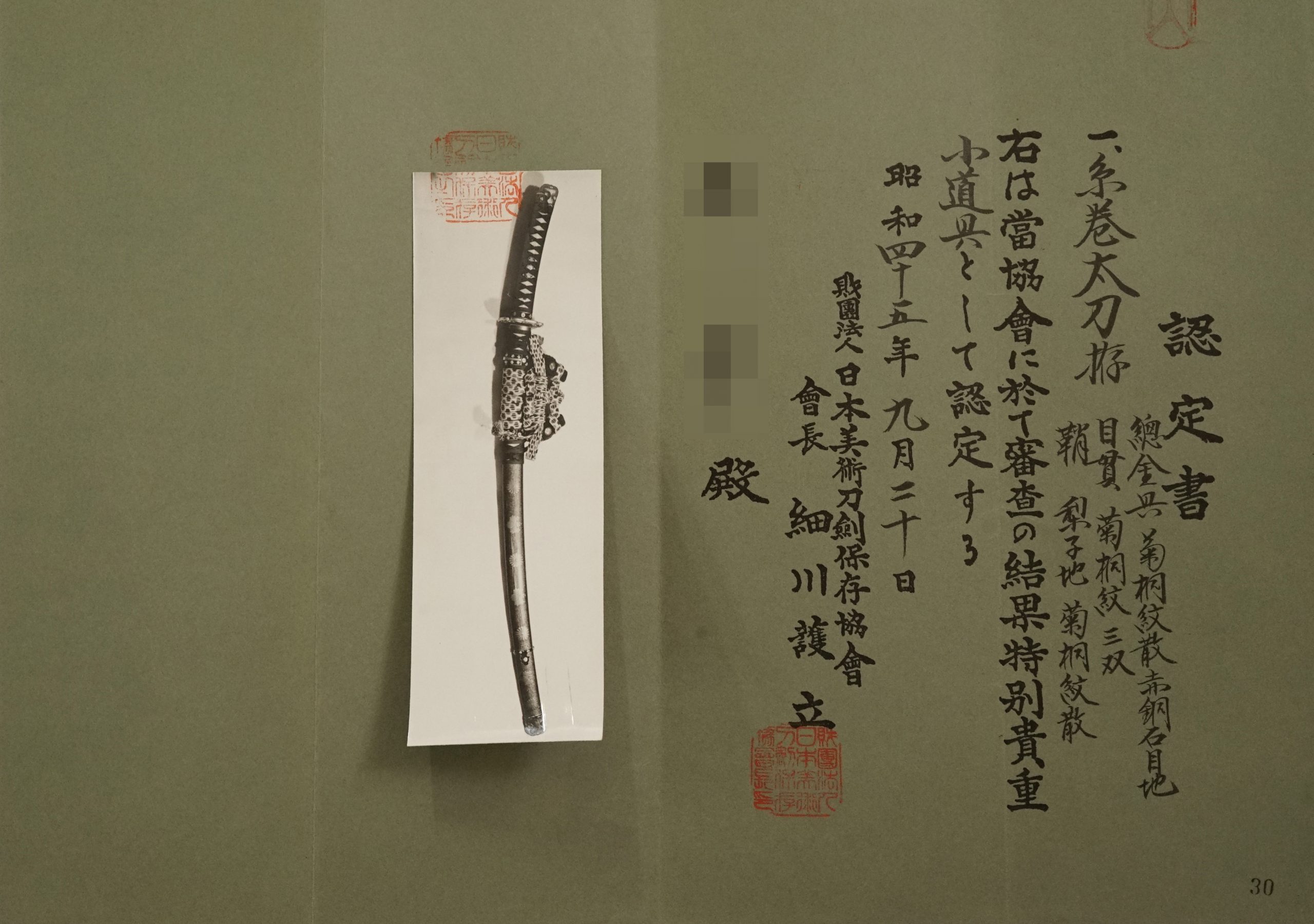
Registration Number : Fukushima 59383
The Board of Education in Fukushima prefecture issued a registration paper for this sword . It is called Jyu Token Rui Torokusho(銃刀剣類登録証). Bunkacho(The Agency for Cultural Affairs) acknowledges a Japanese sword with this paper as a work of art.
The sword needs to be traditionally hand-forged and made of Tamahagane carbon steel to be registered in the system. With this paper, its owner in Japan can legally own an authentic Japanese sword. Based on this registration number, we will apply for its export permit.
This paper will need to be returned to the board of education when the sword is being shipped abroad, but you can receive a copy of it. An English translation of this registration paper is available on request.
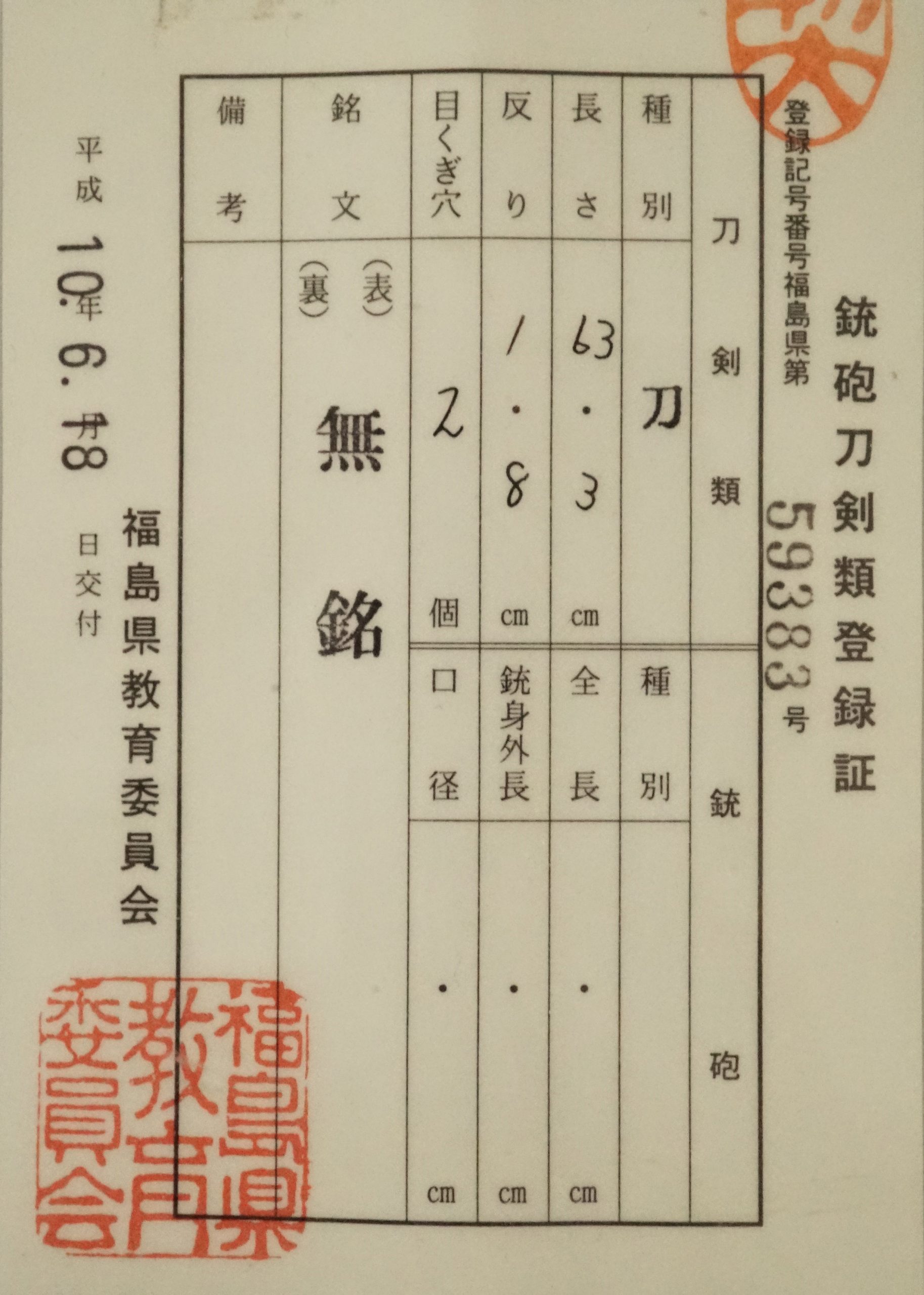
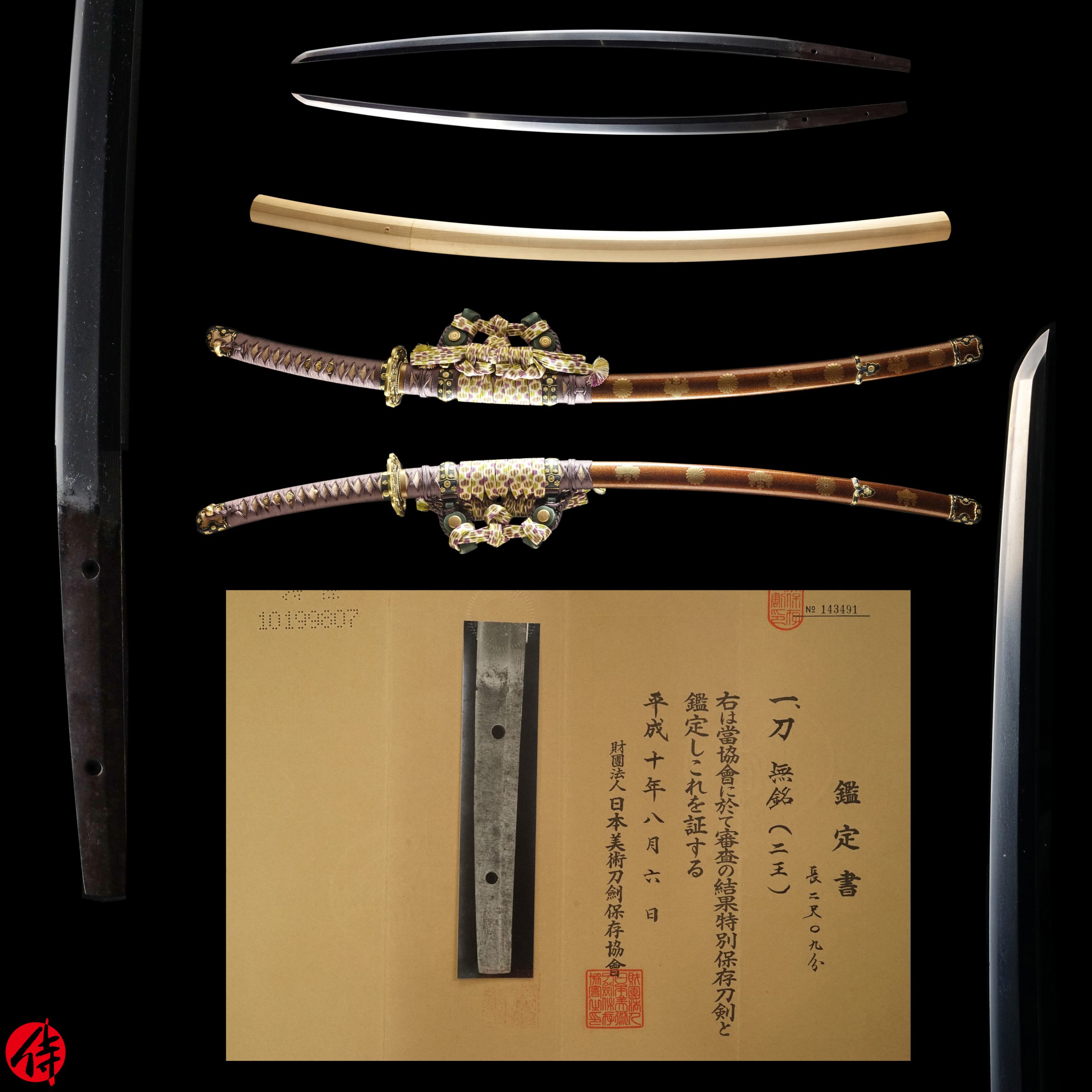
—————————————————————–
【About us】
Samurai Museum is located in Tokyo, Japan, exhibiting antique artifacts related to the Samurai history. Samurai Museum Shop is the place for those who are interested in Japanese culture and craftsmanship. We deal with antique Samurai swords/armor, traditional crafts made in Japan and so on.
【Japanese Sword& Export Process】
The Japanese swords we deal with are hand-forged edged swords made in Japan. It was made from the traditional carbon steel called TAMAHAGANE(玉鋼). Samurai Museum is familiar with the proper legal procedure for an antique/ authentic Japanese sword to be exported from Japan. We have sent more than 300 Japanese swords to amazing owners who appreciate its historical value.
Each Japanese sword is registered under the Agency for Cultural Affairs and the Board of Education in Japan.They issue a registration paper for each Japanese sword for its owner in Japan to legally possess it. The Japanese sword with its registration paper means it was traditionally hand-forged in Japan.
To legally export the sword from Japan to other countries, we will have to apply for its permit to the Agency for Cultural Affairs(Bunkacho) and return the original registration paper to the Board of Education. It normally takes around 2-4 weeks to receive this permit after submitting required documents. And we would like you to expect at least 1-1.5 months for your order to arrive at your given address after you ordered. For more detailed info, please click here.
It is allowed for residents in Japan to own authentic Japanese swords without a special license as long as they come with registration papers. Please feel free to contact us if you are a resident of Japan, whether temporarily or permanently. We will also assist you when you leave Japan and need to obtain the export permit.
【Payment Method】
We accept payment through Stripe(Credit card) or PayPal, both of which are secure payment methods. If you prefer other payment method, please contact us. After confirming the payment from you, we will apply for an export permit. You can either pay in JPY, USD, EUR or GBP. The price is decided in Japanese Yen. The price in other currencies is calculated automatically based on the exchange rate.

【Shipping】
We have shipped authentic Japanese swords to the USA, Canada, Mexico, Australia, UK, Germany , France and Hong Kong. If you don’t live in these countries and like to order, please contact us first before making a purchase. We offer Free International Shipping as long as we can send antique Japanese swords by either EMS or FedEx(Canada).
We normally ship by EMS(Express Mail Service) provided by Japan Post. When we receive an order from the Canada we will use FedEx instead as EMS temporarily stops shipping from Japan to those countries due to COVID-19.
We will send you a tracking number for your order as soon as we hand it to the post office/FedEx. We will put 100 % insurance on the shipping document without any extra charge. Based on the total amount, there might be a duty tax or other fee for you to pay, depending on the countries. We use package cushioning to protect the item and put it in a PVC pipe, which is one of the most secure packages because of its durability.
It will normally takes 5-14 days for the item to arrive at your given address after we dispatch it. Time of delivery is estimated as accurately as possible by the carrier but does not take into account any delays beyond our control such as by inclement weather, post office holiday seasons.
*Please keep in mind that due to the spread of COVID-19, there might be delays in shipping. If you like to know the detail about shipping, please feel free to ask us.

【How to make sure the condition】
Please keep in mind that what you are going to purchase is an antique item. We uploaded high resolution photos for you to check its condition thoroughly. If you like to see more photos with different angles, please feel free to contact us. We will be happy to send them to you so that you can make informed decision. It is essential for us to know that you are happy with your choice of a sword. and we are prepared to use the best of our ability to serve you.
【The Art of Nihonto(Japanese Sword)】
Samurai’s history is a profound, eloquent legacy of ancient Japanese warriors in which millions of people worldwide are being fascinated. If you like to find out the art of Nihonto, please click here.
【A Guide to Japanese Sword Maintenance】
After acquiring an genuine Japanese sword, it is also important to know how to take good care of it. Here is the special video for you. Mr. Paul Martin, Japanese sword expert, shows you how to give proper maintenance to your sword. When you purchase a Japanese sword from us, you can get a Free sword maintenance kit, which appears in this video.

